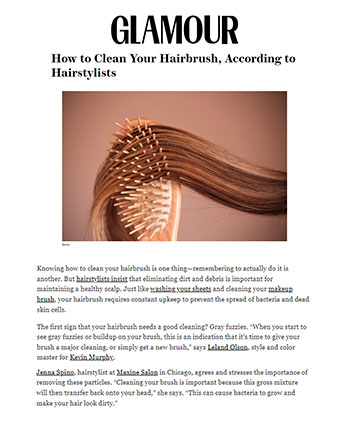Glamour October 3, 2023
 Glamour
Glamour
Hair
How to Clean Your Hairbrush, According to Hairstylists
“A dirty brush can redeposit buildup, bacteria, and dead skin cells to your hair strands and scalp.” Yeah, no.
Knowing how to clean your hairbrush is one thing—remembering to actually do it is another. But hairstylists insist that eliminating dirt and debris is important for maintaining a healthy scalp. Just like washing your sheets and cleaning your makeup brush, your hairbrush requires constant upkeep to prevent the spread of bacteria and dead skin cells.
The first sign that your hairbrush needs a good cleaning? Gray fuzzies. “When you start to see gray fuzzies or buildup on your brush, this is an indication that it’s time to give your brush a major cleaning, or simply get a new brush,” says Leland Olson, style and color master for Kevin Murphy.
Jenna Spino, hairstylist at Maxine Salon in Chicago, agrees and stresses the importance of removing these particles. “Cleaning your brush is important because this gross mixture will then transfer back onto your head,” she says. “This can cause bacteria to grow and make your hair look dirty.”
What are the gray fuzzies on my hairbrush?
The accumulation of gray fuzzies is just as gross as you think. “This buildup is usually a combination of dust, fibers, oils, discarded dry skin cells, and hair products that have been transferred from our hair to the brush,” says Olson.
Using a brush with gray fuzzies can be seriously damaging to your strands, so it's important to clean them off. “Rebrushing this buildup back into your hair can lead to hair issues, odor, and buildup of bacteria on your hair and scalp,” Olson adds.
To help prevent buildup, hairstylist and colorist Dan Williams recommends keeping your brushes in a safe space. “Gray fuzzies are usually dust and particles in the air (clothing/towel fibers) that attach to the bristles,” he says. “It’s important to store your brushes in a closed space and clean them regularly so products such as hairspray, gels, oils, etc., don’t allow for more of these particles to stick.”
How often should I clean my hairbrush?
Consistency is key, and Olson recommends a thorough monthly cleaning. “You should be cleaning your hairbrush thoroughly about once a month as well as your hair combs,” he says. However, there are some exceptions.
“If you have longer or thicker hair, it’s more ideal to be cleaning your brushes and combs every two weeks,” Olson says. “If you find that your brush is getting buildup very quickly due to excessive product buildup in your hair, then I would recommend a weekly brush- and comb-cleaning routine.”
A small preventive step you can take? “Every single time you finish cleaning your hair, pick out and remove any hair that's transferred to your brush bristles immediately,” he says. “This will help prevent further tangles in the hair and brush.”
What happens if I don’t clean my hairbrush?
Cleaning not only promotes a healthy scalp and strands, but it also helps your hairbrush perform better, especially if you've invested in a pricier brush. If you're not regularly cleaning, you may be making the job even harder. “Brushes can range in price on the market depending on the brand, quality of the brush, whether it's a ceramic or natural bristle brush,” Olson says. “You want to clean your brushes regularly to help prevent your hairbrush from not working as intended or effectively.”
Williams agrees, adding that tools are available to help make the cleaning process easier. “Cleaning your brushes regularly keeps the quality of the bristles in better condition,” he says. “It will also allow the brush to work to its highest capacity—when a bunch of hair clogs the brush, you’ll notice the quality of detangling and smoothing deteriorates. You can find brush-cleaning tools on Amazon that make cleaning your brushes a breeze.”
Not cleaning your hairbrush also may inflict damage on your scalp. “When you aren’t cleaning constantly, every time you brush your hair, a dirty brush can redeposit buildup, bacteria, and dead skin cells to your hair strands and scalp,” Olson says. “This also may make detangling your hair much harder to do.”
How to clean a hairbrush
Luckily, how to clean a hairbrush is fairly simple and easy to achieve at home. “For a quick everyday cleansing for someone on the go, simply spray your combs and brushes with a mixture of rubbing alcohol and water to dilute,” says Olson. “This is an easy way to instantly kill any bacteria that may grow on the brush in between thorough cleanings.”
For a deep clean, Olson recommends soaking your brushes and combs in a tub of hot water with cleansing soap. “Please make sure to let your brush fully dry before your use it again,” he says.
Spino likes to add vinegar to her soaking mixture to make sure brushes are fully disinfected. “To truly disinfect, you will have to make a mixture of half water and half vinegar,” she says. “You can soak the brush and rinse well. If there is buildup stuck on the brush, scrub with something like a toothbrush. Depending on how often you use your brush, it should be cleaned once a week to once a month.”
If you're not trying to DIY, Williams uses the Ship Shape Comb and Brush Cleaner to clean his brushes and combs. “Soak the brushes in a tub overnight and rinse them really well the next day with water,” he says. “Your brushes will look and feel brand-new!”
